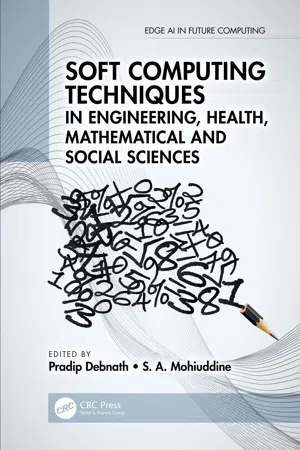
Soft Computing Techniques in Engineering, Health, Mathematical and Social Sciences
- 240 pages
- English
- ePUB (mobile friendly)
- Available on iOS & Android
Soft Computing Techniques in Engineering, Health, Mathematical and Social Sciences
About This Book
Soft computing techniques are no longer limited to the arena of computer science. The discipline has an exponentially growing demand in other branches of science and engineering and even into health and social science. This book contains theory and applications of soft computing in engineering, health, and social and applied sciences. Different soft computing techniques such as artificial neural networks, fuzzy systems, evolutionary algorithms and hybrid systems are discussed. It also contains important chapters in machine learning and clustering. This book presents a survey of the existing knowledge and also the current state of art development through original new contributions from the researchers. This book may be used as a one-stop reference book for a broad range of readers worldwide interested in soft computing. In each chapter, the preliminaries have been presented first and then the advanced discussion takes place. Learners and researchers from a wide variety of backgrounds will find several useful tools and techniques to develop their soft computing skills. This book is meant for graduate students, faculty and researchers willing to expand their knowledge in any branch of soft computing. The readers of this book will require minimum prerequisites of undergraduate studies in computation and mathematics.
Frequently asked questions
Information
1 Revisiting the Machine Learning Algorithms and Applications in Engineering and Computer Science
Contents
1.1 Introduction
Table of contents
- Cover
- Half Title
- Series Page
- Title Page
- Copyright Page
- Table of Contents
- Preface
- Editors
- Contributors
- Chapter 1 Revisiting the Machine Learning Algorithms and Applications in Engineering and Computer Science
- Chapter 2 Detection and Prevention of Cancer through Artificial Intelligence and Machine Learning
- Chapter 3 A Review on Soft Computing Techniques in Nanomagnetism and Its Impact on Biomedical Applications
- Chapter 4 A Mediative Fuzzy Logic-Based Approach to the Goal Programming Problem: In the Context of Multi-Objective Solid Transportation Problem
- Chapter 5 H-U-R Stability Results of Mixed-Type Additive-Quadratic Functional Equation in Fuzzy β-Normed Spaces by Two Different Approaches
- Chapter 6 Tauberian Theorems for Intuitionistic Fuzzy Normed Spaces
- Chapter 7 Picture Fuzzy Soft Matrices
- Chapter 8 Cubic n-Inner Product Space
- Chapter 9 Convergence Methods for Double Sequences and Applications in Neutrosophic Normed Spaces
- Chapter 10 Intuitionistic Fuzzy Generalized Lucas Ideal Convergent Sequence Spaces Associated with Orlicz Function
- Chapter 11 Soft Computing Techniques in Social Sciences: The Recent Developments
- Chapter 12 An Approach Based on Fuzzy Logic for Analysis on Product Development in Open Innovation Context
- Index